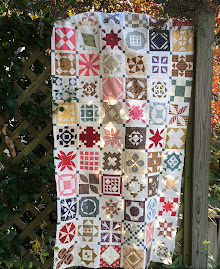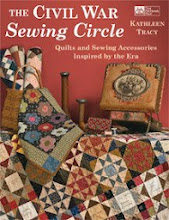Doll quilts from the past stir our hearts and engage our emotions with their simple blocks and imperfect stitches. It's fun to imagine what kinds of quilts children may have made and played with long ago. For me, making little scrappy quilts almost brings the past alive in a way.
Doll quilt from an online auction.
The doll quilt craze is not new, however. This was written in 1831:
"Little girls often find amusement in making patchwork quilts for the beds of their dolls, and some even go so far as to make cradle quilts for their infant brothers and sisters."
I am happy that doll quilts are not just for dolls or children anymore. They have a particular appeal to those of us who have fond memories of playing with dolls as young girls (maybe boys, too . . . ). Doll quilts from long ago were played with until they fell apart and that's why they're so rare today; not many survived the wear and tear.
This little sampler quilt from my book Prairie Children & Their Quilts is a treasure and would be a lot of fun to make with your pink and blue print scraps.
If you follow my blog and books at all, most of you know by now that doll quilts were often used as practice for young girls' sewing skills in the past.
Needlework and sewing were an important part of a girl's education in the 18th and 19th centuries. Quite often, these skills were taught before reading and writing.
Doll quilts were learning pieces. It was the practicing of the sewing skills that was important, not so much the design of the quilt. But I like to think that, like their mothers or other early quilters, even young girls making small quilts for their dolls still learned about color and the whole design process and it helped to give life to their creative expression in a small way. It's the same with many quilters today who are still learning.
I read something recently on a blog that really annoyed me - the blogger wrote something trashing beginning quilters for not making perfect quilts and criticized them for putting up photos of them on their blogs (or, heaven forbid, in books) for everyone to see. How dare they! The quilts were not perfect! What right did they have to bring down the quilting community with their imperfections . . . .
Wait, I thought - Quilts that are not perfect do not deserve to be seen? Had she ever looked at any antique quilts? Beginning quilters do not have the right to show their humble yet earnest quilts and still be considered quilters, even if they are learning? They should hide them until they're perfect? Excuse me, but everyone has to start somewhere. When did perfection take over and exclude many of us from being a part of the larger quilting community if we cut off a corner now and then? Is it now a private club with membership determined by a few? Aren't we supposed to be having fun?
(Okay, I'm done. Sorry I ranted but I needed to get that off my chest. Everyone is entitled to her own opinion and this is mine.)
I learned to quilt myself by making doll quilts. A couple of my early learning pieces, above. Yep - sorry, not perfect, crooked borders, but still cute and near and dear to my heart. Never fear, I will not stop posting photos of my imperfect quilts . . . .
Love this darling vintage quilt on eBay - oops, watch out, some of those corners are cut off . . . . better hide it under a bushel.
I don't own a lot of antique doll quilts. They can get pretty pricey because they're so rare. If I see one that's affordable that I like I may buy it but I often prefer to make my own because sometimes it's fun to be a part of the whole reproducing process yourself. That seems to be what it's all about for me - the process.
Even if they're not perfect, maybe the small quilts we love to make will be valuable to someone someday. And, if not, that's okay. Like little girls' sewing samples, mine were my own simple learning pieces from the past. It's fun to look back and see how far I've come.
(Eliza Jane's nine-patch doll quilt)
I love this quilt for its simplicity.


























































